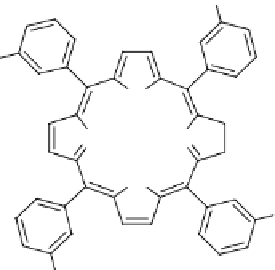Biomedical Engineering Reference
In-Depth Information
Fig. 10
meso
Meta-
tetra(hydroxyphenyl)chlorin
(
m
-THPC) (Reproduced by
permission of The Royal
Society of Chemistry)
HO
HO
H
N
N
N
OH
OH
Fig. 11
Methylene blue
(MB) (Reproduced by per-
mission of The Royal Society
of Chemistry)
N
N
S
N
Cl
characterize
1
O
2
formation, anthracene-9,10-dipropionic acid (ADPA) was used as
it is easily converted to an endoperoxide and the fluorescence of ADPA was fol-
lowed
vs
the time of irradiation. The rate constant of the reaction of
1
O
2
with ADPA
was determined for PS in solution and for PS embedded inside the nanoparticles.
This rate was higher for the nanoparticles, suggesting that
1
O
2
production from
nanoparticles exceeded that of free PS.
The same group published the encapsulation of methylene blue (MB, Fig.
11
), a
promising drug for PDT applications (Tang et al.
2005b
). Intravenous administra-
tion of MB has been approved by the Food and Drug Administration (FDA) for
methemoglobinemia. However, clinical use of methylene blue (MB) is limited
partly because of the poor penetration of this drug in the cellular compartment of
the tumor. Furthermore, methylene blue is usually inactivated
via
the reduction of
the cation to the neutral leukomethylene blue which has negligible photodynamic
activity. Encapsulation of methylene blue inside silica nanoparticles is a way to
vectorize it and protect it towards degradations.
Two methods were performed for its encapsulation. The Stöber procedure was
successful for the immobilization of the PS inside pure silica, giving nanoparticles
with a diameter of 190 nm. Alternatively organically modified silica (ORMOSIL)
nanoparticles were prepared by combining methyltrimethoxysilane and phenylt-
rimethoxysilane as precursors. This procedure resulted in nanoparticles with a
diameter of 160 nm, revealing a hydrophobic outer shell and a hydrophilic inner
core. The loading of PS was higher with the Stöber procedure than with ORMOSIL
nanoparticles. However, reaction of
1
O
2
with ADPA after irradiation of the nanopar-
ticles at 650 nm showed a higher kinetic rate with ORMOSIL than with Stöber
nanoparticles, although the production of
1
O
2
with the Stöber nanoparticles was









Search WWH ::

Custom Search